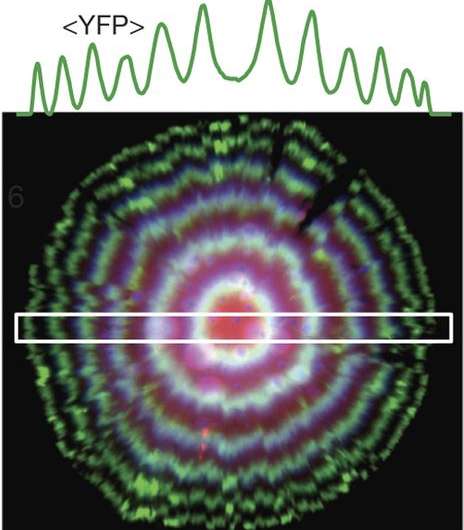October 13, 2016 report
Researchers improve accuracy of synthetic clock

(Phys.org)—A team of researchers with Harvard University and the University of Cambridge has successfully improved the accuracy of a synthetic clock known as a repressilator. In their paper published in the journal Nature, the team describes the steps they took to reduce the amount of noise in the biological system and how well it worked. Xiaojing Gao and Michael Elowitz with the California Institute of Technology offer a News & Views piece on the work done by the team and explain how their results could improve understanding of natural gene circuits.
Scientists have noted the high precision that some living cells demonstrate in keeping track of time, such as those that are part of the circadian clock, and have tried to duplicate the process. Sixteen years ago, Michael Elowitz and Stanislas Leibler developed what is now known as the repressilator—a synthetic oscillating genetic circuit. Their results demonstrated that it was possible for genetic circuits to be designed and built in the lab. The resulting circuit functioned, but was noisy, and therefore much less accurate than natural cell clocks. In this new effort, the researchers improved several of the design steps of the repressilator, each greatly reducing the amount of noise, and in so doing, increased the precision.
The repressilator was made using repressor proteins that would bind to DNA sequences that were adjacent to a gene to be targeted for inhibition. Three repressors were created such that each one represented the expression of the next cycle—when the protein in one repressor increased, it caused a decrease in the expression of the second, which in turn caused an increase in expression of the third, and so on, resulting in oscillations—the actions were monitored by reporters. Unfortunately, each was bothered by random fluctuations known as noise. To reduce the noise, the researchers integrated the reporters into the repressilator, engineered the repressor proteins to degrade in order to reduce the number of copies made, and increased the binding threshold between one of the repressors and the DNA sequence.
In testing their improvements, the researchers found they had reduced the standard deviation of the period length from 35 percent to just 14 percent, which Gao and Elowitz describe as extraordinary precision—good enough to allow large numbers of cells to remain in sync.
More information: Laurent Potvin-Trottier et al. Synchronous long-term oscillations in a synthetic gene circuit, Nature (2016). DOI: 10.1038/nature19841
Abstract
Synthetically engineered genetic circuits can perform a wide variety of tasks but are generally less accurate than natural systems. Here we revisit the first synthetic genetic oscillator, the repressilator, and modify it using principles from stochastic chemistry in single cells. Specifically, we sought to reduce error propagation and information losses, not by adding control loops, but by simply removing existing features. We show that this modification created highly regular and robust oscillations. Furthermore, some streamlined circuits kept 14 generation periods over a range of growth conditions and kept phase for hundreds of generations in single cells, allowing cells in flasks and colonies to oscillate synchronously without any coupling between them. Our results suggest that even the simplest synthetic genetic networks can achieve a precision that rivals natural systems, and emphasize the importance of noise analyses for circuit design in synthetic biology.
Journal information: Nature
© 2016 Phys.org

















